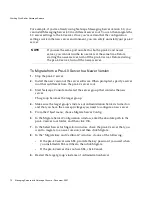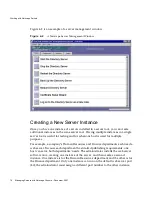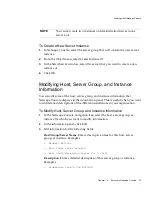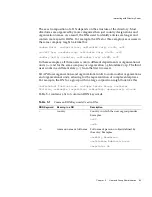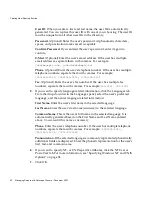
Interacting with Directory Server
82
Managing Servers with Netscape Console • December 2001
Using Distinguished Names
A distinguished name (DN) is a text string that identifies a specific directory
branch or entry. Each user and group in your enterprise is represented in the
Directory Server by a DN. Whenever you make changes to user and group
information in the Directory, you use distinguished names (DNs). For example,
you need to specify a DN each time you perform one of the following operations:
•
Create or modify directory entries
•
Set up access controls
•
Set up user accounts for applications such as mail or publishing
From the Netscape Console “Users and Groups” tab, you can create, select, and use
directory entries.
Distinguished Names, Attributes, and Syntax
This section presents a brief summary of distinguished names, directory attributes,
and syntax information. For a more detailed discussion of these concepts, see the
Netscape Directory Server Administrator’s Guide
.
Distinguished Names
A
distinguished name
(DN) is the string representation of an entry’s name and
location in an LDAP directory. A DN describes a path to a directory entry. Each
DN is made up of a number of components called
relative distinguished names
(RDNs). Each RDN identifies a specific entry in the directory. In order to ensure
that every directory entry is unique, LDAP dictates that a single parent entry
cannot have two identical RDNs below it.
Customarily, a DN for a user or group contains at least three types of RDN:
•
A user name, user ID, or group name (identified by the
cn
keyword)
•
An organization name (identified by the
o
keyword)
•
One or domain name components (identified by the
dc
keyword). Example:
example.com
contains two domain name components: example and
com
.
Other common RDNs are organizational unit (
ou
), state (
st
), and country (
c
).
Summary of Contents for NETSCAPE CONSOLE 6.0 - MANAGING SERVERS
Page 1: ...Managing Servers with Netscape Console Netscape Console Version6 0 December 2001 ...
Page 18: ...Getting Additional Help 18 Managing Servers with Netscape Console December 2001 ...
Page 20: ...20 Managing Servers with Netscape Console December 2001 ...
Page 40: ...Uninstallation 40 Managing Servers with Netscape Console December 2001 ...
Page 42: ...42 Managing Servers with Netscape Console December 2001 ...
Page 80: ...Working with Netscape Servers 80 Managing Servers with Netscape Console December 2001 ...
Page 110: ...110 Managing Servers with Netscape Console December 2001 ...
Page 118: ...The Netscape Administration Page 118 Managing Servers with Netscape Console December 2001 ...
Page 166: ...166 Managing Servers with Netscape Console December 2001 ...
Page 208: ...Using Client Authentication 208 Managing Servers with Netscape Console December 2001 ...
Page 226: ...Using the Windows NT SNMP Service 226 Managing Servers with Netscape Console December 2001 ...
Page 228: ...228 Managing Servers with Netscape Console December 2001 ...
Page 264: ...Managing Certificates 264 Managing Servers with Netscape Console December 2001 ...
Page 280: ...The SSL Handshake 280 Managing Servers with Netscape Console December 2001 ...
Page 302: ...302 Managing Servers with Netscape Console December 2001 ...





